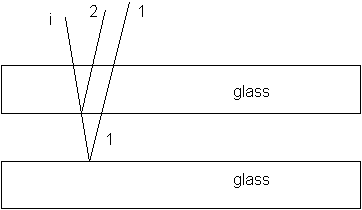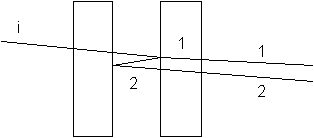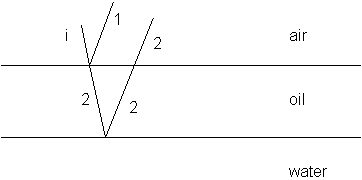| Ch.37 | 8 | 9 | SP1 | 35 | 29 | 38 | 59 |
8 . THIS IS EASY !
Take a look at the following graphic:
What does this picture tell you? It should say that the first minima (m= 0 in eqn.37.6 ) are directly across from each slit. Use formula 37.6 and set m = 0. Solve for L. By the way, what value do you use for Ydark ? Look at the above graphic and make your decision based on simple geometric (i.e. common sense!) analysis and the information given on the distance d between the slits! |
|||||||
|
9. Use the "far field" approximation of equations 37.5 and
37.6. With that said and done, we continue.
Use Equation 37.6 since we are talking about a minimum: |
|||||||
| SP1. At a
particular location in a Young's interference pattern, the intensity on
the screen is 6.4% of the maximum. (a) What minimum phase difference ( in radians) between sources produces this result? (b) Find the path difference r2 - r1 for 587.5 nm light.
(b):
|
|||||||
| 35.
The initial ray i is shown entering the left slab. Analyze the two rays that emerge
from the right slab. Ray 1, which is transmitted from i without reflection, has undergone
no phase change. Ray 2 has undergone two reflections before emerging from the right slab.
There is a 1800 phase change at each reflection. Thus the net effect of these
two reflections is no phase change at all. Thus, the phase difference between ray 1 and
ray 2 is determined only by the extra distance that ray 2 travels before emerging on the
right. Thus we have for constructive interference (bright-transmitted light) the usual
relationship: Note that the index of refraction of the glass does not effect the problem because the extra distance that ray 2 travels in the air gap, where n = 1. Find the minimum distance d. What value of m does that correspond to ?
|
|||||||
| 29.(a)
The initial ray i divides into two rays, ray1 that reflects off the first interface,
and ray 2 that reflects off the second interface. Ray 1 undergoes a 1800 phase
change since n for oil is greater than n for air. Ray 2 experiences no phase change since
n for water is less that that for oil. Thus we have the "unusual" relations for
constructive interference: |
|||||||
38. The air gap behaves differently than in problem
35 since
we are looking at the reflected rays , not the transmitted rays. Let's represent the
air gap of thickness d to analyze the reflections.: Refer also to fig. 37.16. Ray 1 undergoes a phase change of 1800 upon reflection. Ray 2 undergoes no phase change. A dark band occurs when there is destructive interference: This is the "unusual " condition because of the 1800 phase change for ray 1. Note that the wavelength is for light in a vacuum since the gap between the glass is air. Calculate m at the position of maximum thickness on the left end using the value of d at that location. Note that there is destructive interference at the position of zero thickness on the right end since at that point ray 1 is exactly 1800 out phase with ray 2. Therefore you must add the number 1 to the value of m you compute. The air gap varies between zero at the right end and the maximum d at the left end. Therefore, the number of values of thickness d corresponding to destructive interference and hence the number of dark bands is m + 1. |
|||||||
| 59. Look at fig
P37.59. Let L be the length of each diagonal.
Thus:
or,
And for destructive,
Or,
|
|||||||


